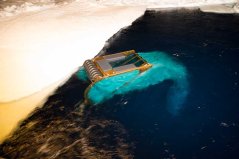Blog post
Fishing under Antarctic sea ice
Researchers on expedition to Antarctica with Polarstern, are fishing with an ice net: the SUIT (Surface and Under Ice Trawl). A video shows how it works.

Foto: Chief Mate Uwe Grundmann and Michiel keep watch over the towing cable during the haul of the SUIT.
Fishing under ice?
During earlier marine research in the Antarctic, the ice covered areas consistently showed higher abundances of large top predators than the open waters further north. Seals, whales, penguins and tubenosed seabirds are abundant, but the unanswered question is where they can find sufficient food? Nets going down into the water column do not show sufficiently rich food supplies. The explanation for this paradox may possibly be found directly at the undersurface of the ice, where ice algae and other microscopic life flourishes. Here, missed by traditional nets, the first step into a rich food chain might be found.

SUIT, alias the ‘Kampfwagen’
In order to investigate what happens at the undersurface of the sea-ice, IMARES in its Antarctic research has designed a special net. With this floating net, we can sort of scrape along the bottom of the sea ice. To prevent large chuncks of ice from entering and ripping the net, its front is made of a large iron frame that can take the crashes with the ice and guides large chunks of ice away from the entrance of the net. The formal name of our net is ‘SUIT’ which stands for Surface and Under-Ice Trawl. The German crew of Polarstern has nicknamed it the ‘Kampfwagen’ like an old roman chariot that is taking up the battle with the merciless sea ice.
The role of SUIT in the WISKY expedition
In this Polarstern Expedition, the SUIT is only one of many approaches to learn more about what happens along the undersurface of the sea ice. In addition to many traditional studies of the water column, this expedition also makes many physical records of sea ice characteristics. For microscopic biological research, ice cores are drilled and taken out. A diving team uses a range of approaches to study details of life under an icefloe at the scale of some tens of meters. An Australian team on board works with a Remotely Operated Vehicle (ROV), which resembles a mini submarine that can for example work to distances of about 200m. And finally the SUIT is again one step up on the spatial scale. All this together should improve our understanding of what is happening under the sea ice.
The attached 3-minute video tries to give a quick impression of how our SUIT net is operated. In a later message we will show some more of its catches.
Jan Andries van Franeker